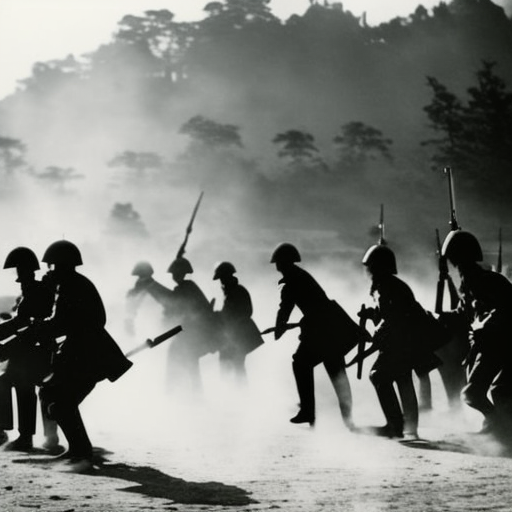Battle of Jiuliancheng: A Decisive Clash in the Chinese Civil War
The Battle of Jiuliancheng was a crucial military engagement that took place during the Chinese Civil War between the Nationalist Government, led by Chiang Kai-shek, and the Communist Party of China, led by Mao Zedong. The battle occurred from September 25 to October 15, 1945, in the northeastern province of Liaoning, China. It marked a turning point in the conflict and had far-reaching implications for the outcome of the civil war.
Background:
By 1945, the Chinese Civil War had been raging for nearly two decades. The Nationalist Government and the Communist Party had been vying for control of China, each with their own vision for the country’s future. The Nationalists, who had the support of the United States, controlled the central government in Nanjing, while the Communists held significant territory in the north.
The Battle:
The Battle of Jiuliancheng began when the Nationalist forces launched a major offensive against the Communist-held region in northeastern China. The Nationalists aimed to eliminate the Communist threat and establish control over the area. The battle was fought primarily between the Nationalist Northeastern Army and the Communist Northeastern Field Army.
The Nationalists, with their superior numbers and better-equipped troops, initially made significant gains. They captured several key towns and pushed the Communists back. However, the Communists, led by General Lin Biao, employed guerrilla warfare tactics and launched counterattacks, inflicting heavy casualties on the Nationalists.
As the battle progressed, the Communist forces managed to regroup and launch a successful counteroffensive. They cut off the Nationalist supply lines and encircled their troops. The Nationalists, facing a dire situation, attempted to break out of the encirclement but were met with fierce resistance. The battle turned into a protracted siege, with both sides suffering heavy losses.
Outcome:
After three weeks of intense fighting, the Battle of Jiuliancheng ended in a decisive victory for the Communists. The Nationalist forces were forced to retreat, leaving behind a significant amount of equipment and supplies. The battle demonstrated the effectiveness of guerrilla warfare tactics employed by the Communists and highlighted the weaknesses of the Nationalist forces.
The Communist victory at Jiuliancheng had significant implications for the Chinese Civil War. It boosted the morale of the Communist forces and allowed them to expand their influence in northeastern China. The battle also exposed the Nationalist Government’s inability to effectively combat the Communist insurgency.
Moreover, the Battle of Jiuliancheng marked a turning point in the civil war. It convinced many Chinese citizens that the Communist Party was a viable alternative to the Nationalist Government. The battle contributed to the erosion of public support for the Nationalists and helped solidify the Communist Party’s position as a major political force in China.
In conclusion, the Battle of Jiuliancheng was a decisive clash in the Chinese Civil War that took place in 1945. It resulted in a significant victory for the Communist forces and had far-reaching implications for the outcome of the conflict. The battle showcased the effectiveness of guerrilla warfare tactics employed by the Communists and exposed the weaknesses of the Nationalist forces. Ultimately, the Battle of Jiuliancheng played a crucial role in solidifying the Communist Party’s position as a major political force in China.












